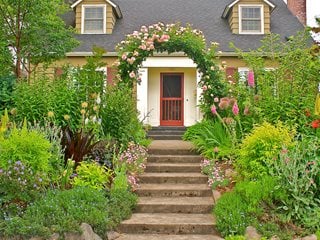
Create a grand entrance to your home with a rose-covered arbor. Gardener: Mary DeNoyer. Photo by: Janet Loughrey.
Include climbing roses to maximize your space. Train other vining plants such as clematis to grow up through shrub or climbing roses to create exciting flower combinations.
Grow horizontally:
Train climbers along a fence to define garden rooms or to soften an unsightly chain link fence.
Plant in containers:
Many roses can be successfully grown in containers, a good solution for small spaces, apartment balconies, patios, and decks. Containers should be at least 15 to 20 inches in diameter and 18 to 24 inches deep. Half whiskey barrels work well. Miniature roses can be grown in smaller pots or hanging baskets. (See more on growing roses in pots.)
Cover a slope:
Mass groundcover varieties such as Flower Carpet® or Drift® roses along a slope for low-maintenance erosion control.
Plant in drifts:
For greater impact, plant in groups of 3-5 specimens of the same variety.
Plant a hedge:
Plant a row of taller shrub roses to create privacy from the street. A row of shorter groundcover roses can be planted along a foundation, in a curbside strip, or used to define garden areas.
Make an entrance:
Create a grand entrance to your home with an inviting entryway complete with a rose arbor and adjacent plantings to soften the landscape.
Create a transition:
Use a rose-covered arbor in a side yard to define the transition between front and back yards.
Use as a background planting:
Place climbers along a tall wooden fence to soften the backdrop and break up the expanse of wood.
Foundation planting:
Combine landscape roses with other shrubs that bloom at different times along the front of your home for a season-long display of color.
Mixed border:
Use low-growing ground cover roses near the front of a mixed border or taller semi-climbers in back to establish height and layers.
WHAT TO PLANT WITH ROSES
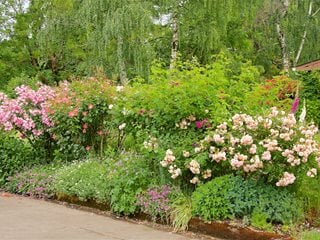
A curbside planting of roses underplanted with perennial geraniums offers screening and privacy. Garden and photo by: Janet Loughrey.
A rose garden can be greatly enhanced by incorporating other plants as part of the overall design. Roses go well with a wide variety of trees, shrubs, perennials and annuals. Choose plants that have the same cultural requirements of full sun, ample water and rich soil.
Also, consider how much maintenance your roses will need:
- Hybrid teas, grandifloras, floribundas, climbers, and miniatures all require regular maintenance and pruning, as well as winter protection in cold climates. Companion plants should be confined to in front of or behind roses, not in between them, to allow easy access.
- Species, shrub, old garden, and landscape roses require only minimal maintenance: cleaning up in winter and deadheading as needed when in bloom. These types of roses can be surrounded with perennials, annuals, bulbs, and shrubs.
Flowering companions:
Intersperse plants that flower at different times to extend the bloom season. These can include perennials or annuals such as petunia, verbena, or calibrachoa.
Complement and contrast:
Pair roses with other plants in complementary hues to create drama and contrast. A gold-colored rose such as Oso Easy Lemon Zest® would pair well with Rapido Blue Carpathian bellflower or ‘Violet Profusion’ salvia.
Trees:
Add different heights to a mixed border or formal rose garden with trees. These can include snowbell (Styrax japonicus), fringe tree (Chionanthus virginicus), dogwood (Cornus) and crabapple (Malus).
Shrubs:
Enhance the landscape by providing contrasting color, texture, and structure with shrubs. These can include boxwood, spirea, bluebeard, and daphne.
Groundcovers:
Use groundcovers as a living mulch and weed-suppressing carpet. Good rose companions include perennial geraniums, dead nettle, bugleweed, and lady’s mantle.
Perennials:
Provide contrast with perennials of different size, structure, and color. Good rose companions include alliums, lavender, catmint, salvia, phlox, and speedwell.
Vines:
Climbers can be trained up or alongside rose plants for an extra layer of color. These may include clematis, climbing bleeding heart (Dicentra scandens), morning glory and jasmine.
ROSE GARDEN IDEAS
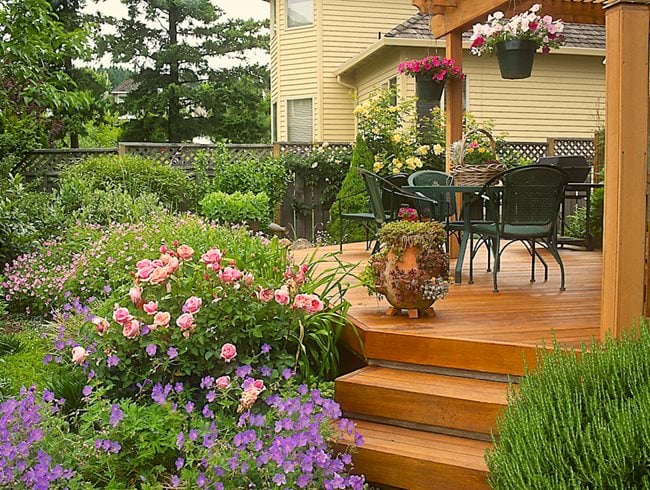
Plant fragrant rose varieties near a deck or patio to enjoy their fragrance up close. Gardener: Diana Gough. Designer: Phil Thornburg. Photo by: Janet Loughrey.
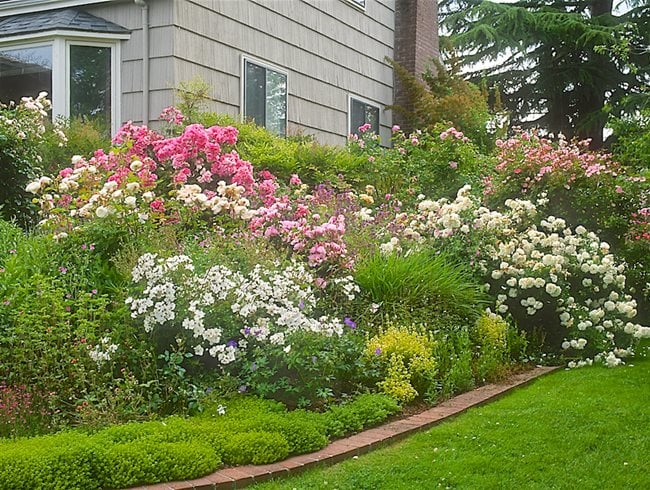
Combine roses with other plants of different heights for a layered tapestry. Gardener: Jeff Clark. Photo: Janet Loughrey.
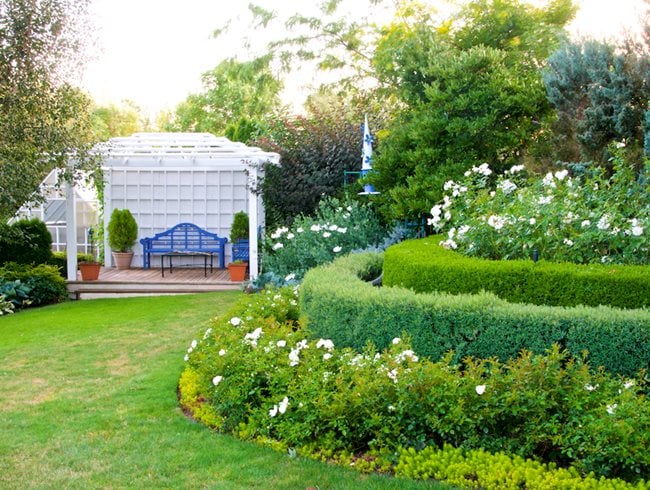
A formal rose garden is characterized by distinct lines, clipped hedging and structures such as pergolas and arbors. Gardener and designer: Nancy Cutler. Photo: Janet Loughrey.
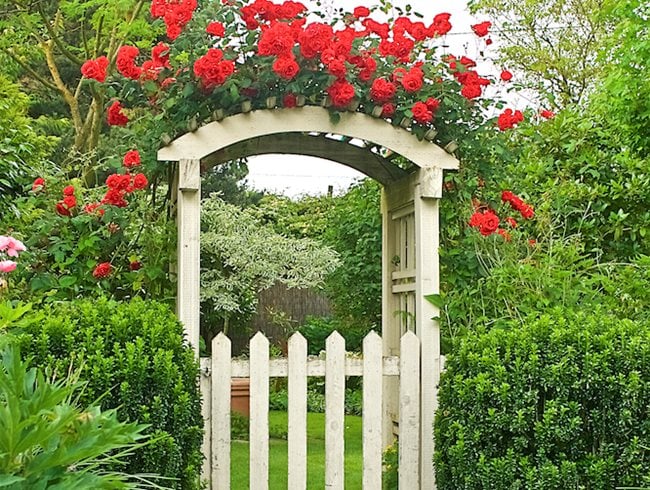
A rose-covered gate marks the transition between the front and back yards. Gardener: Mary DeNoyer. Photo: Janet Loughrey.
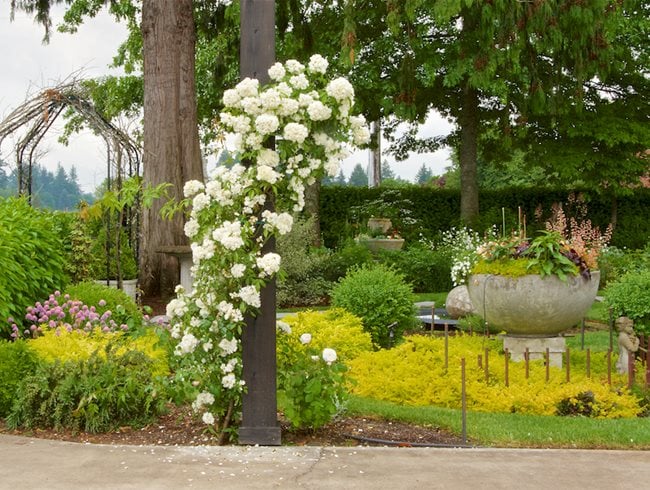
Train roses vertically to add varying layers to the landscape. Gardeners: Darin Simmons and Matthew Greydanus, Laurel Hedge. Photo: Janet Loughrey.
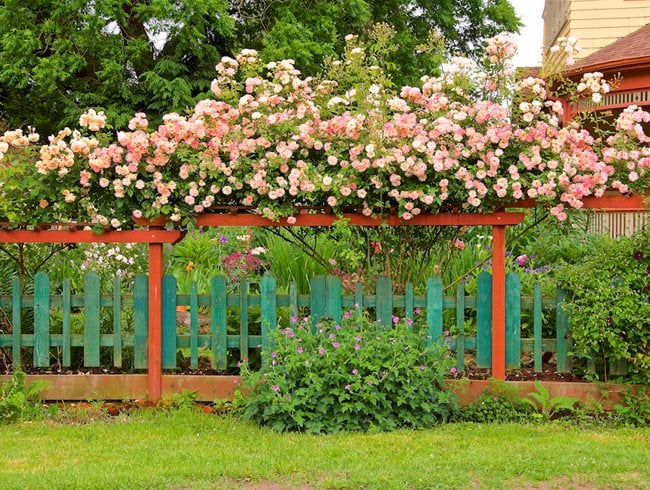
Train climbing roses along a fence to create an attractive screen for privacy. Gardeners: Danny Hills and Wayne Hughes, Lonesomeville Gardens. Photo: Janet Loughrey.
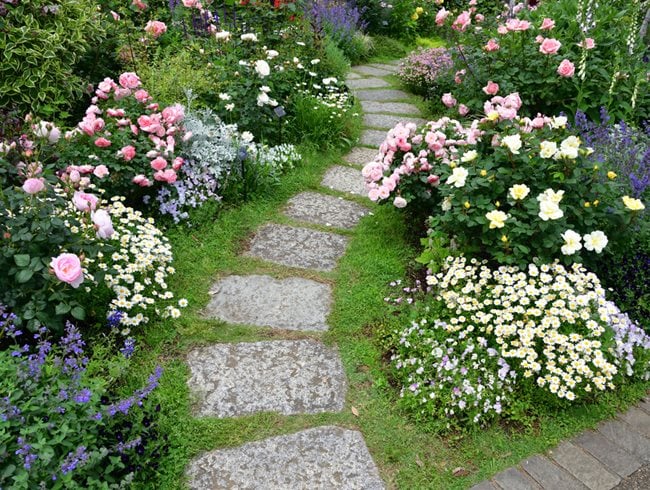
Roses combine well with many perennials, shrubs, trees, and annuals. Photo: Matthewshutter / Shutterstock.





